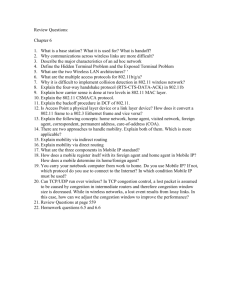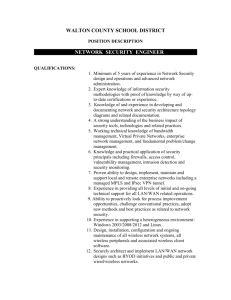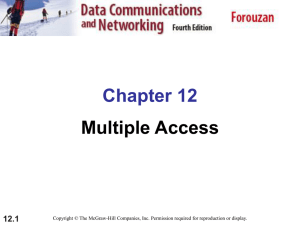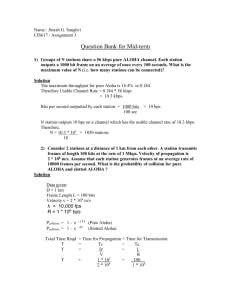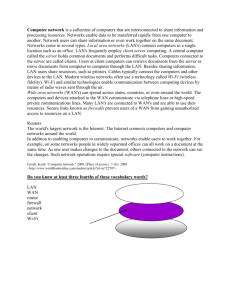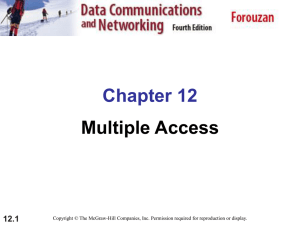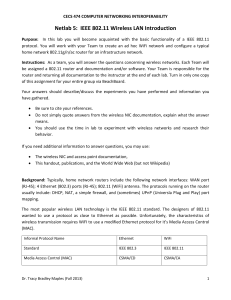CUSTOMER_CODE SMUDE DIVISION_CODE SMUDE
advertisement
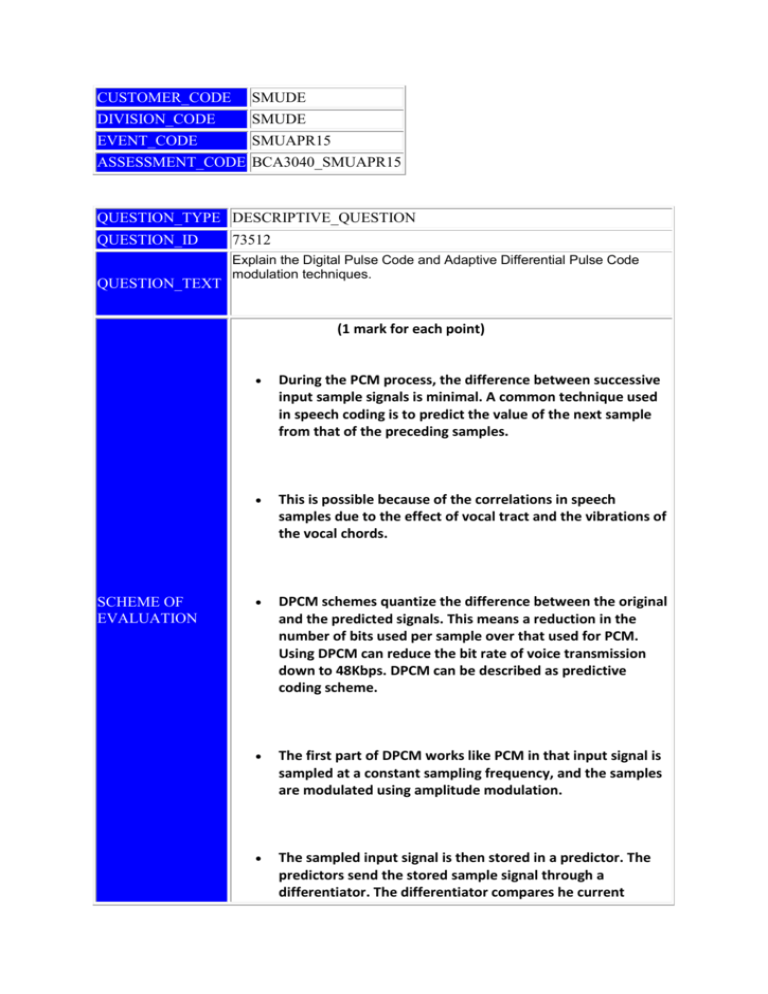
CUSTOMER_CODE SMUDE DIVISION_CODE SMUDE EVENT_CODE SMUAPR15 ASSESSMENT_CODE BCA3040_SMUAPR15 QUESTION_TYPE DESCRIPTIVE_QUESTION QUESTION_ID QUESTION_TEXT 73512 Explain the Digital Pulse Code and Adaptive Differential Pulse Code modulation techniques. (1 mark for each point) SCHEME OF EVALUATION During the PCM process, the difference between successive input sample signals is minimal. A common technique used in speech coding is to predict the value of the next sample from that of the preceding samples. This is possible because of the correlations in speech samples due to the effect of vocal tract and the vibrations of the vocal chords. DPCM schemes quantize the difference between the original and the predicted signals. This means a reduction in the number of bits used per sample over that used for PCM. Using DPCM can reduce the bit rate of voice transmission down to 48Kbps. DPCM can be described as predictive coding scheme. The first part of DPCM works like PCM in that input signal is sampled at a constant sampling frequency, and the samples are modulated using amplitude modulation. The sampled input signal is then stored in a predictor. The predictors send the stored sample signal through a differentiator. The differentiator compares he current sample signal with the previous sampling signal and sends it to the quantizing and coding phase of PCM. After quantizing and coding, the difference signal is transmitted. At the receiver, the difference signal is dequantized, added to a sample signal stored in a predictor and sent to a low-pass filter that reconstructs the original input signal. Although DPCM reduce the bits rate for voice transmission, the uniform quantization used means that large sample signals have higher signal-to-noise ratio than small sample signals, so voice quality is better at higher signals. Adaptive Differential Pulse Code modulation: (2+1)marks o In ADPCM the predictor and quantizer are adaptive. It adapts the quantization levels of different signals that are generated during the DPCM process. If the difference signal is low, ADPCM reduces the size of the quantization levels. If the difference signal is high ADPCM increases the size of quantization levels. o The quantization level is adapted to the size of the input difference signal, generating a uniform signalto-noise ratio throughout the dynamic range of the difference signal. QUESTION_TYPE DESCRIPTIVE_QUESTION QUESTION_ID 73514 Discuss the important requirements for wireless LAN. QUESTION_TEXT SCHEME OF EVALUATION The important requirements of wireless LAN are: (1x10)M Throughput: The medium access control protocol should make efficient use of wireless medium to maximize capacity. Number of nodes: Wireless LANs may need to support hundreds of nodes across multiple cells. Connection to backbone LAN: IN most cases, interconnection with stations on a wired backbone LAN is required. There may also need to be accommodation for mobile users and ad hoc wireless network. Service area: A typical coverage area for a wireless LAN has a diameter of 100m to 300m. Battery power consumption: Mobile workers use battery-powered workstations that need to have a long battery life when used with wireless adapters. Transmission robustness and security: Wireless LAN must permit reliable transmission even in a noisy environment and should provide some level of security from eavesdropping. Collocated network operation: Interference between the LANs is possible when two or more wireless LANs operate in the same area or in some area. Such interference may thwart the normal operation of a MAC algorithm and may allow unauthorized access to a particular LAN. License Free operation: Users would prefer to buy and operate wireless LAN products without having to secure a license for the frequency band used by the LAN. Handoff/roaming: The MAC protocol used in the wireless LAN should enable mobile stations to move from one cell to another without any problems. Dynamic configuration: The MAC addressing and network management aspects of the LAN should permit dynamic and automated addition, deletion, and relocation of end systems without disruption to other users. QUESTION_TYPE DESCRIPTIVE_QUESTION QUESTION_ID 73516 QUESTION_TEXT What is congestion control? Explain one congestion control technique. SCHEME OF EVALUATION Congestion control is concerned with controlling traffic entry into a network so as to avoid congestive collapse by attempting to avoid oversubscription of any of the processing or link capabilities of the intermediate nodes and networks and taking resource reducing steps, such as reducing the rate of sending packets. (2 marks) Explain any one of the following techniques: Backpressure Choke packet Implicit congestion signalling Explicit congestion signaling (8 marks) QUESTION_TYPE DESCRIPTIVE_QUESTION QUESTION_ID QUESTION_TEXT 125759 Explain the different types of errors and the error detecting methods. Different types of errors are: Single bit error: It means only 1 bit of a given data unit is changed from 1 to 0 or from 0 to 1. Single bit errors are the least likely type of error in serial data transmission. For example of 00000010 was sent, but 00001010 was received, meaning single bit error resulted 2M Burst Error: Means 2 or more bits in the data unit have changed from 1 to 0 or from 0 to 1. Suppose that the data 0100010001000011 was sent, but 0101110101100011 was received. Note that the burst error results. More bits in the data unit have changed. Error does not mean that the errors occur in consecutive bits. The length of the burst is measured from the first corrupted bit to the last corrupted bit. Some bits in between may not have been corrupted. A burst error is more likely to occur than the single-bit errors. 3M Error Detection methods: The different error detection methods are: SCHEME OF EVALUATION 1. Parity checking method 2. Cyclic Redundancy Check (CRC) Parity Checking is a simple error detection method used with character oriented protocols. One bit in every character bit sequence is reserved for parity. This bit is set by the transmitter to 0 or 1 so that the total number of one bit in the character is always even or always odd. The receiver checks for parity bit of each character to see if it as expected. Parity checking is effective in detecting an odd number of bit errors in an character. If even numbers of bits in a character are corrupted then this will go unnoticed. 2.5M CRC: The CRC is a technique for detecting errors in digital data, but not for making correction when errors are detected, It is used in data transmission. In the CRC, a certain number of check bits, often called a checksum, are appended to the message being transmitted. The receiver can determine whether or not to check bits agree with the data, to as certain with a certain degree of probability whether or not an error occurred in transmission. If an error occurred, the receiver sends a “negative acknowledgement” back to the sender, requesting that the message be retransmitted. 2.5M QUESTION_TYPE DESCRIPTIVE_QUESTION QUESTION_ID 125760 QUESTION_TEXT Explain the following: a. Pure ALOHA b. Slotted ALOHA c. CSMA d. CSMA/CD a. Pure ALOHA: The original ALOHA protocol is called pure ALOHA. This is a simple, but elegant protocol. The basic idea is that each station sends a frame whenever it has a frame to send. since there is only one channel to share, there is the possibility of collision between frames from different stations. b. Slotted ALOHA: Slotted ALOHA was invented to improve the efficiency of pure ALOHA. In slotted ALOHA the time is divided into slots of the average time required to send out a frame, and force the station to send only at the beginning of the time slot. SCHEME OF EVALUATION c. Carrier Sense Multiple Access (CSMA): If a station senses the medium before trying to use it. then collision can be reduced. Carrier sense multiple access requires that each station first listen to the medium before sending. When a station sends a frame, and any other station tries to send a frame during this time, a collision will result. But if the first bit of the frame reaches the end of the medium, every station will already have heard the bit and will not send its own frame. d. Carrier Sense Multiple Access with Collision Detection (CSMA/CD): The CSMA method does not specify the procedure following a collision. But the carrier sense multiple access with collision detection (CSMA/CD) method, a station monitors the medium after it sends a frame to see if the transmission was successful. If, so the station is finished. If there is any collision, the frame is sent again. QUESTION_TYPE DESCRIPTIVE_QUESTION QUESTION_ID 125761 QUESTION_TEXT What are advantages and disadvantages of digital communication over analog communication? Advantages SCHEME OF EVALUATION 1. Immunity to noise is relatively high. 2. Efficient use of communication bandwidth 3. Data encryption 4. The ability to detect errors and correct them. 5. Designing and manufacturing is cheaper. 6. Much data communication is computer to computer. Disadvantages 1. Requires more bandwidth 2. Additional encoding and decoding circuitry required.
